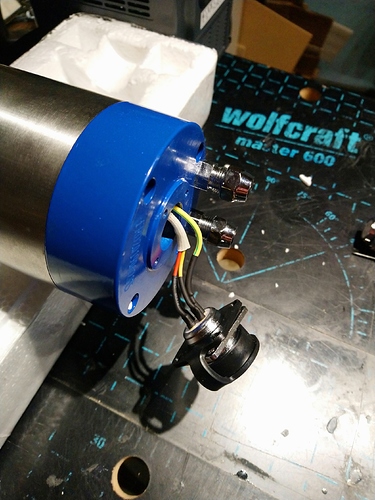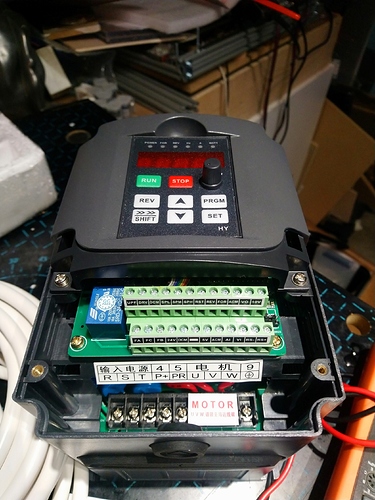You have a thing for blue don’t you?
Yeah, who would ever use just an open bucket. . .
It’s not mine! I’m just… uhhhh… holding it for a friend… Yeah, that’s it.
Grabs keys and heads to the hardware store
Interesting! I was just helping a friend today with mounting his new spindle. He bought it from Amazon, Chinese mfg. and ONE 5" X 8" paper with instructions, but they were in English. The big thing about these is that instructions to set up the control unit are extremely limited and on video at UTube.
The big thing I noticed between the router he had and the spindle was the noise level. He had it running at 24k and it was quieter than the fan on the control unit.
Dang if I would have known about the G-Penny Spindles I would have gone that route so it matched the blue of all Lukes stuff.
Unboxing the G-penny BST-2.2C-80-24K, man this thing is huge and heavy.
If the side by side comparison of the collet nut vs the Makita’s is any indication:
First thing I checked is the runout inside the collet taper: it is below the rated precision of my dial indicator (0.01mm / 0.0004"), visually it looks like it could be ~0.005mm / 0.0002". We’ll see how much I get at the endmill level using the provided ER collets.
The packaging was quite good, lots of protection. The inverter comes with a 60 page user manual in what looks like decent English. So far so good.
There is however a MAJOR issue: the blue of the spindle does not quite match the blue of the BeaverCNC mount 
How much does it weigh? Does the manual include a speed, torque and power curve? The C in the model number likely suggests that you chose the ceramic bearing version, is that correct? Here’s Kennametal’s description of the pros and cons of steel and ceramic bearings.
It weighs 5.4Kg / close to 12lb.
The user manual does not seem to have any interesting power/torque/speed curve, but honestly I did not go through it yet. I found it online as a pdf if you want to have a look
That’s the VFD manual so it wouldn’t have info (power/torque/speed curve, etc.) on the spindle/motor (which is required to setup the VFD properly). That relatively light weight, the fact that the case says “220V, 10A, and 2.2kW”, and 220V X 10A = 2.2 kW makes me wonder if the 2.2kW is the input rather than the output power rating - as it should! It should be plenty powerful enough anyway, but you’ll need to know how to setup the VFD for the motor.
more than probably so. I bought it for the quiet and RPM automation, the 1000+watt output power may come in handy later.
I checked the claim that the spindle is grounded, and indeed the 4th wire (pin 4 of the aviation connector) is connected and has continuity with the spindle body (I checked with a multimeter). Good.
- the input 220V power plug I will use has live, neutral, and earth.
- I plan to use a 4core 1.5mm² cable I have on hand, to wire the spindle pins 1/2/3/4, to terminals U/V/W and Earth of the VFD.
So I would end up connecting both the earth wire from the 220V plug and the earth wire from the spindle body, to terminal 9 (Earth) of the VFD:
Which sounds consistent with the diagram on the first page of this (very interesting) guide I stumbled upon:
but since earthing details are scarce in the posts I found here on the forum, I thought I would double check here.
Also, my 4 core wire is not shielded : from your experience, it is worth going for a shielded 4core cable instead, to prevent any possible EMI issue ?
I’ve not found had any emi issues from running non shielded cable on the spindle.
@Julien
"the input 220V power plug I will use has live, neutral, and earth."
So 220V 50 Hz line voltage (hot to neutral - which is apparently earth referenced somewhere) is the French residential standard utility power? US’s standard is two 115 V 60 Hz line voltages (hot to neutral - which are earth referenced at the service panel) that are 180 degree phase shifted (for 230 V phase - phase voltages for high power loads). Interesting! I wonder if the 50 Hz transformer/ballast buzz is as annoying as 60 Hz is!
well yeah the 3 phase power in europe is 380V 
(120 degrees from eachother)
@fenrus
380V 3 phase provides 219V line voltages - which is good. Most 3 phase in US is 208V (maximum) which gives 120V line voltages - which is good. But the phase voltage is only 208V which isn’t really high enough for many moderate single phase 220V - 240V loads like motors!  And we’re still stuck with the imperial measurement system - I had to figure out what a “slug” is the other day!
And we’re still stuck with the imperial measurement system - I had to figure out what a “slug” is the other day!
what’s a slug then ? 
A body that exerts 143 Newton’s of force in one standard gravity as I recall.
That’s enough insane units for one day, I’ll keep my metric system thank you 
There is the Metric system and that other system that put a man on the moon. 
You really think a man was put on the moon?




